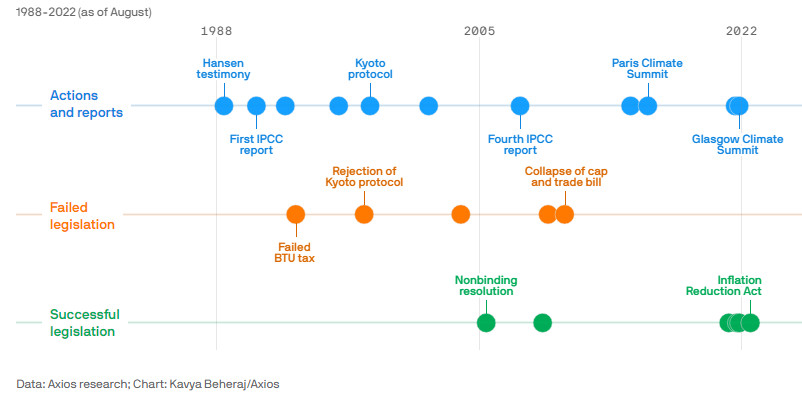
OVERVIEW
MANAGEMENT
PERFORMANCE
POSSIBILITIES
CAPITALS
ACTIVITIES
ACTORS
BURGESS
|
NEWS HEADLINES
AXIOS Axios Smart Brevity news for August 11th 2022 
Original article: Peter Burgess COMMENTARY Peter Burgess | ||
|
Good morning! Today's newsletter has a Smart Brevity count of 1,232 words, 5 minutes. Written by Ben Geman and Andrew Freedman, edited by Mickey Meece August 11, 2022 1 big thing: Why this climate bill is different 
Data: Axios research; Chart: Kavya Beheraj/Axios The Democrats' climate bill that the House is expected to take up tomorrow follows decades of legislative failure on climate change, Andrew writes. Why it matters: If the bill passes and heads to President Biden's desk, experts say it will be because Democrats abandoned the strategy of simply making carbon emissions too painful to maintain — and because Americans are now increasingly aware of the costly impacts of climate change. The big picture: The bill, by Senate Majority Leader Chuck Schumer (D-N.Y.) and Joe Manchin (D-W.Va.), would inject about $370 billion into the economy for expanding the use of clean energy, boosting climate resilience for communities, and beginning to decarbonize industrial sectors. Between the lines: It stands in stark contrast to the approach favored by environmental economists and key lawmakers for decades. Past attempts to tackle climate change relied on putting a price on carbon through a carbon tax or a so-called cap and trade system. Both would have regulated the global warming gas from the top down, by making such pollution more expensive. Notable but doomed attempts to pass climate legislation occurred in 2003 and 2009. What they're saying: Jason Grumet, founder and president of the Bipartisan Policy Center, said the environmental movement and lawmakers made a mistake by following the economists. 'The biggest political malpractice over the last 30 years was buying into the Econ 101 notion that government shouldn't pick technology, that Congress and elected officials should support a strategy which will be perceived as painful with no political narrative of success,' Grumet told Axios in an interview. This changed beginning in 2018, once scientists agreed that more technologies, including as-yet-unproven ones that would draw carbon out of the air, would be needed to avert potentially catastrophic impacts from global warming, Grumet said. The intrigue: Paul Bledsoe, who served as a climate staffer in the Clinton White House, also pointed to the mistake of designing policies around economic concepts that lacked political support. The environmental movement and lawmakers 'somehow got bamboozled by the economists,' he said. In addition, this bill is also poised to meet a different fate than the many bills buried in the climate legislation graveyard because of the falling costs of clean energy, particularly solar and wind power, Bledsoe said. Lastly, a large, diverse and determined social movement also kept up the pressure on Democrats to keep trying to agree to legislation. The other side: Republican opposition to the new climate bill was unanimous in the Senate and is likely to be nearly so in the House, with lawmakers arguing that it would raise taxes, add to inflation and make fossil fuel development more expensive. Read the whole story. 2. Oil's back to the future moment 
Illustration of a hand balancing an oil barrel. Illustration: Aïda Amer/Axios Oil use in power generation and industry is 'soaring' as high natural gas and electricity prices prompt fuel switching, the International Energy Agency said, Ben writes. Why it matters: It's why IEA, in this morning's latest monthly market report, slightly boosted its global oil demand growth estimate for 2022 despite economic headwinds. 'With several regions experiencing blazing heatwaves, the latest data confirm increased oil burn in power generation, especially in Europe and the Middle East but also across Asia,' IEA said. 'Fuel switching is also taking place in European industry, including refining.' The intrigue: Use of oil for electricity had mostly fallen for decades, though it rose last year, and it's a small source of global power (roughly 3% last year, per the European NGO Ember). But oil emits more CO2 per unit burned than natural gas, so we'll see the effect on 2022 emissions when the data's in. The big picture: The IEA report takes stock of a market that has loosened in recent months and stockpiles have risen, sending prices mostly lower since mid-June. One reason: 'More limited declines in Russian supply than previously forecast.' Still, IEA cautions that another price rally can't be ruled out due to supply disruption risks. 3. New support for electric planes 
Archer Aviation's electric vertical takeoff plane Photo courtesy of Archer Aviation This week is bringing fresh momentum for startups looking to deploy electric vertical takeoff and landing (eVTOL) aircraft, Ben writes. Driving the news: Archer Aviation yesterday announced a $10 million 'pre-delivery payment' from United Airlines on United's 2021 plan to buy 100 of the startup's aircraft. Meanwhile, Joby Aviation, another California eVTOL startup, announced the expansion of its contract with the U.S. Air Force. 'It brings the potential value of the total contract to more than $75 million,' Joby said. The contract also includes work with the Marine Corps, they said. The big picture: The announcements Wednesday are part of wider support for the sector. For instance, in April Beta Technologies said it closed a $375 million Series B funding round. Yes, but: Don't look up yet and expect to see these things dotting the skies, but the tech is advancing toward commercialization. Archer notes that it recently completed its 'preliminary design review,' a step along the way toward regulatory compliance. 'The Federal Aviation Administration has not yet approved those vehicles to begin ferrying passengers, but the down payment is a sign of support from United that the technology is valid,' Fortune notes. The intrigue: TechCrunch explains why the military, which is working with multiple eVTOL developers, is so interested in the tech. Part of it's for green reasons, but also eVTOLs 'promise a lower noise profile — all the better for stealth operations — as well as a lower cost to operate and potentially more flexibility for missions and operations.' 4. Europe's heat, drought and wildfire woes 
Map showing a model projection of extreme heat in Western Europe ... temperature departures from average on Friday, Aug. 12, 2022. (Weatherbell.com) Western Europe's fourth region-wide, fierce heat wave of the summer is well underway, Andrew writes. It's pushing temperatures into the triple digits Fahrenheit in Portugal, Spain, France, and close to that level in the United Kingdom. Threat level: French firefighters are battling a nearly 20,000-acre blaze in the Gironde region that has forced thousands from their homes, while other fires burn elsewhere in the heat-affected regions. In the U.K., where temperatures are forecast to soar into the mid-to-upper 90s today through Sunday, the Met Office has hoisted an Amber 'Extreme Heat Warning' through the period. The fire danger in southeast England is forecast to reach its two highest categories, 'very high' to 'exceptional,' with authorities warning that they may not be able to respond to every call. During the record-breaking heat wave in July, fires swept through parts of London and London's mayor said it was the busiest day for fire crews since World War II. What's next: Much of Europe is in the middle of an intense drought, which the heat will only intensify. Context: Heat waves are likely to occur, more intense, and longer lasting due to human-caused climate change. 5. Cities roll out 'resilience hubs' to combat heat 
Image of the 'resilience hub' in Miami country Miami's climate resilience pod. Courtesy of the Adrienne Arsht-Rockefeller Foundation Resilience Center As cities race to amp up their heat mitigation efforts, some are replacing bare-bones cooling centers with 'climate resilience hubs' — offering everything from comfy A/C and phone charging to social services and more, Axios' Jennifer A. Kingson reports. Why it matters: While the hubs are meant for everyone and all kinds of climate disasters, they're particularly aimed at low-inc0me residents and people of color, who tend to suffer disproportionately as temperatures rise. Driving the news: Chastened by heat waves that have often turned fatal, cities and states are starting to plan, fund and build hubs — souped-up community centers modernized for the current heatpocalypse. Miami-Dade County is at the forefront with its mobile 'resilience pod' made from a 40-foot shipping container. Initiatives are also underway in cities in Tempe; Austin; Seattle; Portland; Northern California and elsewhere. Read the whole story. 🙏Thanks for reading and we'll see you back here tomorrow. News worthy of your time
| The text being discussed is available at | and |